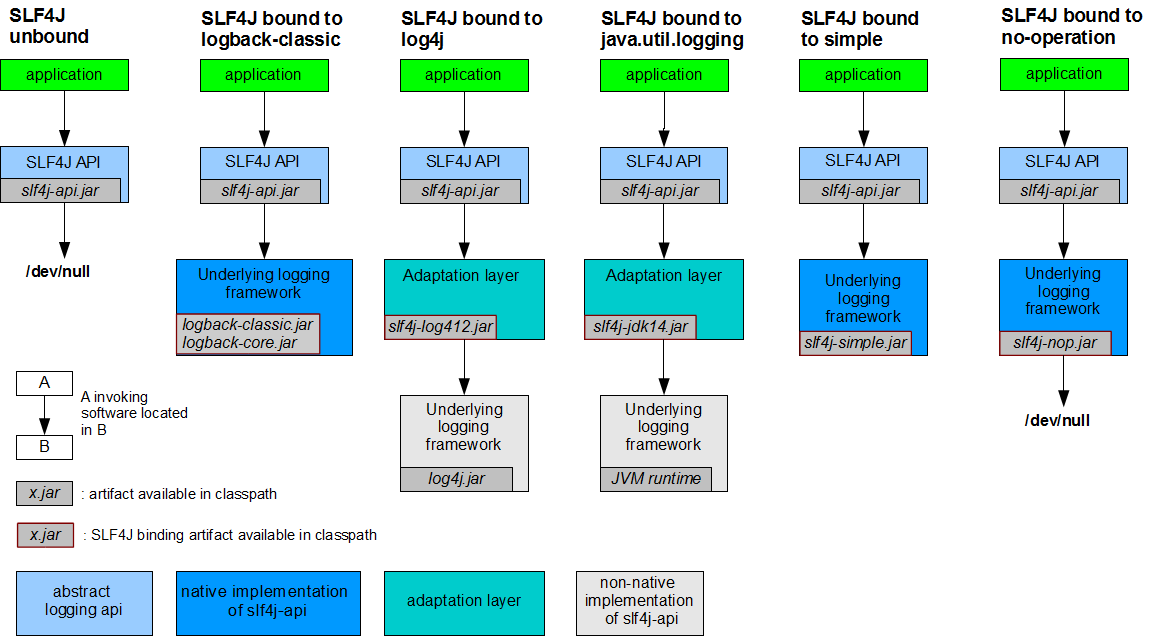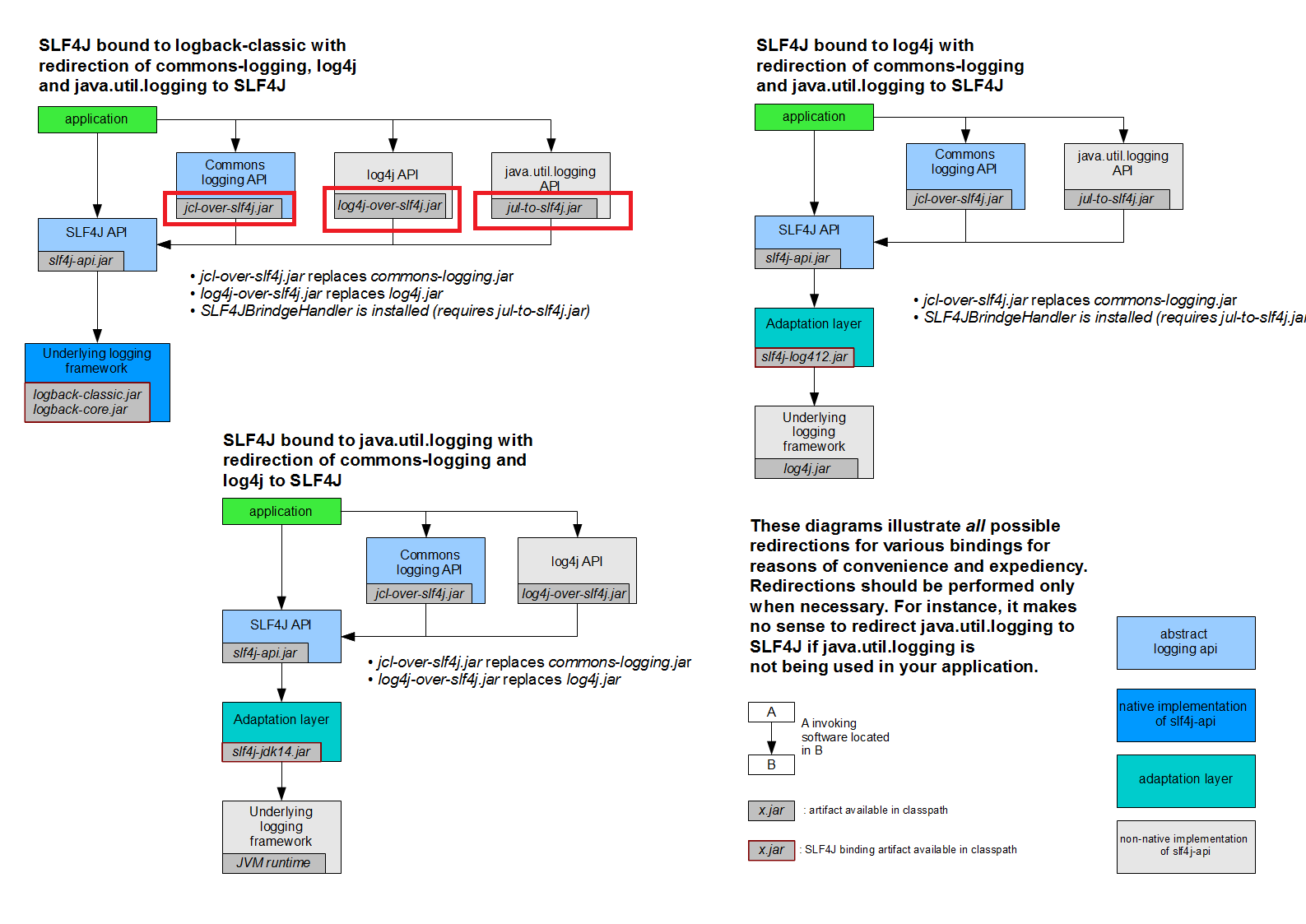
版本:
1.我选用的日志框架:
- 日志门面(抽象层): SLF4J
- 日志实现: Logback
Spring Boot: 底层是Spring框架,Spring框架默认是JCL;
而Spring Boot选用 SLF4j和Logback
2. SLF4j使用
1) 如何在系统中使用SLF4j
SLF4j的官方手册
开发的时候,日志记录方法的调用,不用改直接调用日志的实现类,而是调用日志抽象层里的方法;
- 导入slf4j的jar和 logback的实现jar
1
2
3
4
5
6
7
8
9
| import org.slf4j.Logger;
import org.slf4j.LoggerFactory;
public class HelloWorld {
public static void main(String[] args) {
Logger logger = LoggerFactory.getLogger(HelloWorld.class);
logger.info("Hello World");
}
}
|
SLF4j与其他日志框架结合示意图:

2) 遗留问题
虽然我使用的是(slf4j & logback),但是其他的比如Spring框架用的commons-logging日志框架, Hibernate用的是jboss-logging日志框架,等等,太乱了了,所以我们要 统一日志记录,即使别的框架也要和我一起统一使用slf4j进行输出;
官方给出的示意图:

逻辑:
- 1.将系统其他的日志框架排除;
- 2.用中间包来替换原有的日志框架(红色框起来的就是中间包);
- 3.导入slf4j其他的实现
3. Spring Boot日志关系
其实是这个依赖的这个包:
1
2
3
4
5
6
| <dependency>
<groupId>org.springframework.boot</groupId>
<artifactId>spring-boot-starter-logging</artifactId>
<version>2.1.5.RELEASE</version>
<scope>compile</scope>
</dependency>
|
在 pom文件下鼠标右键点击:

SpringBoot所有依赖关系图,我们只看logging相关的:

我用的是2.1.5版本的Spring Boot, 笔者在学习过程中发现我看的老师视频里跟我的版本不一样,
这是那位老师的版本:

很明显跟我不一样,不过Spring肯定对自己的底层进行了升级;
确切的说不是升级,而是剔除掉了jcl框架的转换,因为jcl框架最后更新日期是2014年,明显已经过时
但是基本推理的出来,slf4j的官网图确实是对SpringBoot1.x版本的示意,但是对我的2.x版本不符, 不过根据我的包名来看,他们的功能是差不多的,都是转成slf4j;
小总结:
- 1.SpringBoot底层也是 slf4j+logback的方式j进行日志记录;
- 2.SpringBoot也把其他日志都替换成了slf4j;
- 3.中间替换包;
中间替换包图示:

4) 如果我们要引入其他的框架,一定要把这个框架默认日志依赖移除掉!
Spring框架默认的日志框架是: commons-logging;
但是Spring Boot引入spring核心jar包的时候去除了 日志jar包;
Spring Boot能自动适配所有的日志,而且底层使用 slf4j+logback的方式记录日志,引入其他框架的时候,只需要把这个框架依赖的日志排除掉
4. 日志使用
测试类:
1
2
3
4
5
6
7
8
9
10
11
12
13
14
15
16
17
18
19
20
21
22
23
24
25
| import org.junit.Test;
import org.junit.runner.RunWith;
import org.slf4j.Logger;
import org.slf4j.LoggerFactory;
import org.springframework.boot.test.context.SpringBootTest;
import org.springframework.test.context.junit4.SpringRunner;
@RunWith(SpringRunner.class)
@SpringBootTest
public class SpringBootLoggingApplicationTests {
Logger logger = LoggerFactory.getLogger(getClass());
@Test
public void contextLoads() {
logger.trace("这是trace日志..");
logger.debug("这是debug调试日志..");
logger.info("这是info日志..");
logger.warn("这是warn日志...");
logger.error("这是error错误日志");
}
}
|
运行输出结果:
1
2
3
| 2019-07-02 19:22:35.980 INFO 8404 --- [ main] c.c.s.SpringBootLoggingApplicationTests : 这是info日志..
2019-07-02 19:22:35.981 WARN 8404 --- [ main] c.c.s.SpringBootLoggingApplicationTests : 这是warn日志...
2019-07-02 19:22:35.981 ERROR 8404 --- [ main] c.c.s.SpringBootLoggingApplicationTests : 这是error错误日志
|
也就是说 SpringBoot默认的日志级别是 info,所以只输出了info 和 比info级别大的日志;
打开我的yml配置文件:
1
2
3
| logging:
level:
com.carson: trace
|
意思是把我 com.carson下的所有包都设置为 trace 日志级别
输出结果:
1
2
3
4
5
| 2019-07-02 19:29:17.406 TRACE 7076 --- [ main] c.c.s.SpringBootLoggingApplicationTests : 这是trace日志..
2019-07-02 19:29:17.407 DEBUG 7076 --- [ main] c.c.s.SpringBootLoggingApplicationTests : 这是debug调试日志..
2019-07-02 19:29:17.407 INFO 7076 --- [ main] c.c.s.SpringBootLoggingApplicationTests : 这是info日志..
2019-07-02 19:29:17.408 WARN 7076 --- [ main] c.c.s.SpringBootLoggingApplicationTests : 这是warn日志...
2019-07-02 19:29:17.408 ERROR 7076 --- [ main] c.c.s.SpringBootLoggingApplicationTests : 这是error错误日志
|
4.1 配置文件详解:
1
2
3
4
5
6
7
8
9
| logging.level.com.carson= trace
# path: 只创建任意一个文件夹, SpringBoot会默认生成一个 spring.log 作为日志文件
logging.path= F:/spring/log
# file: 指定一个路径和文件把 日志输出到 指定文件里
logging.file= F:/springboot.log
# pattern.console: 控制台输出的日志格式
logging.pattern.console= %d{yyyy‐MM‐dd} === [%thread] === %‐5level === %logger{50} ==== %msg%n
# pattern.file : 指定文件中日志的输出格式
logging.pattern.file= %d{yyyy‐MM‐dd} === [%thread] === %‐5level === %logger{50} ==== %msg%n
|
4.2 指定配置
| 日志框架 |
文件命名 |
| Logback |
logback-spring.xml, logback-spring.groovy, logback.xml, or logback.groovy |
| Log4j2 |
log4j2-spring.xml or log4j2.xml |
| JDK (Java Util Logging) |
logging.properties |
以上来自SpringBoot的官方文档, 上面是他要求的命名,SpringBoot会读取的
1
2
3
4
5
6
7
8
9
10
11
12
13
14
15
16
17
18
19
20
21
22
23
24
25
26
27
28
29
30
31
32
33
34
35
36
37
38
39
40
41
42
43
44
45
46
47
48
49
50
51
52
53
54
55
56
57
58
59
60
61
62
63
64
65
66
67
68
69
70
71
72
73
74
75
76
77
78
79
80
81
82
83
84
85
86
87
88
89
| <?xml version="1.0" encoding="UTF-8"?>
<configuration scan="false" scanPeriod="60 seconds" debug="false">
<property name="LOG_HOME" value="/app/log" />
<property name="appName" value="atguigu-springboot"></property>
<appender name="stdout" class="ch.qos.logback.core.ConsoleAppender">
<layout class="ch.qos.logback.classic.PatternLayout">
<springProfile name="dev">
<pattern>%d{yyyy-MM-dd HH:mm:ss.SSS} ----> [%thread] ---> %-5level %logger{50} - %msg%n</pattern>
</springProfile>
<springProfile name="!dev">
<pattern>%d{yyyy-MM-dd HH:mm:ss.SSS} ==== [%thread] ==== %-5level %logger{50} - %msg%n</pattern>
</springProfile>
</layout>
</appender>
<appender name="appLogAppender" class="ch.qos.logback.core.rolling.RollingFileAppender">
<file>${LOG_HOME}/${appName}.log</file>
<rollingPolicy class="ch.qos.logback.core.rolling.TimeBasedRollingPolicy">
<fileNamePattern>${LOG_HOME}/${appName}-%d{yyyy-MM-dd}-%i.log</fileNamePattern>
<MaxHistory>365</MaxHistory>
<timeBasedFileNamingAndTriggeringPolicy class="ch.qos.logback.core.rolling.SizeAndTimeBasedFNATP">
<maxFileSize>100MB</maxFileSize>
</timeBasedFileNamingAndTriggeringPolicy>
</rollingPolicy>
<layout class="ch.qos.logback.classic.PatternLayout">
<pattern>%d{yyyy-MM-dd HH:mm:ss.SSS} [ %thread ] - [ %-5level ] [ %logger{50} : %line ] - %msg%n</pattern>
</layout>
</appender>
<logger name="com.atguigu" level="debug" />
<logger name="org.springframework" level="debug" additivity="false"></logger>
<root level="info">
<appender-ref ref="stdout" />
<appender-ref ref="appLogAppender" />
</root>
</configuration>
|
把上面配置复制一份,放到项目的 resources 里面,或者自定义配置,命名规范的区别:
1
2
3
4
5
6
7
8
9
10
11
| <springProfile name="prod">
</springProfile>
<springProfile name="dev | prod">
</springProfile>
<springProfile name="!dev">
</springProfile>
|
也就是刚才的配置文件里的:
1
2
3
4
5
6
7
8
9
10
11
12
13
14
15
16
17
18
19
| <appender name="stdout" class="ch.qos.logback.core.ConsoleAppender">
<layout class="ch.qos.logback.classic.PatternLayout">
<springProfile name="dev">
<pattern>%d{yyyy-MM-dd HH:mm:ss.SSS} ----> [%thread] ---> %-5level %logger{50} - %msg%n</pattern>
</springProfile>
<springProfile name="!dev">
<pattern>%d{yyyy-MM-dd HH:mm:ss.SSS} ==== [%thread] ==== %-5level %logger{50} - %msg%n</pattern>
</springProfile>
</layout>
</appender>
|
你可以在你的 yml或者properties里配置一条:
1
2
| > spring.profiles.active= prod
>
|
来设置运行环境
4.3 使用 log4j
其实SpringBoot官方为我们做了一些帮助:
| Name |
Description |
Pom |
spring-boot-starter-jetty |
Starter for using Jetty as the embedded servlet container. An alternative to spring-boot-starter-tomcat |
Pom |
spring-boot-starter-log4j2 |
Starter for using Log4j2 for logging. An alternative to spring-boot-starter-logging |
Pom |
spring-boot-starter-logging |
Starter for logging using Logback. Default logging starter |
Pom |
spring-boot-starter-reactor-netty |
Starter for using Reactor Netty as the embedded reactive HTTP server. |
Pom |
spring-boot-starter-tomcat |
Starter for using Tomcat as the embedded servlet container. Default servlet container starter used by spring-boot-starter-web |
Pom |
spring-boot-starter-undertow |
Starter for using Undertow as the embedded servlet container. An alternative to spring-boot-starter-tomcat |
Pom |
想使用哪个日志框架就直接导入哪个包就好了, 比如我想使用 log4j2 我先把默认的 spring-boot-starter-logging 排除掉 , 排除方法如下:

1
2
3
4
5
| <dependency>
<groupId>org.springframework.boot</groupId>
<artifactId>spring-boot-starter-log4j2</artifactId>
<version>2.1.1.RELEASE</version>
</dependency>
|
导入log4j2的包;
- 然后在 resources 里 创建一个 log4j的配置文件,文件命名就以刚才说的:
内容:
1
2
3
4
5
6
7
8
9
10
11
12
13
14
15
16
17
18
19
20
21
22
23
24
| ### set log levels ###
log4j.rootLogger = debug , stdout , D , E
### 输出到控制台 ###
log4j.appender.stdout = org.apache.log4j.ConsoleAppender
log4j.appender.stdout.Target = System.out
log4j.appender.stdout.layout = org.apache.log4j.PatternLayout
log4j.appender.stdout.layout.ConversionPattern = %d{ABSOLUTE} ===== %5p %c{ 1 }:%L - %m%n
#### 输出到日志文件 ###
#log4j.appender.D = org.apache.log4j.DailyRollingFileAppender
#log4j.appender.D.File = logs/log.log
#log4j.appender.D.Append = true
#log4j.appender.D.Threshold = DEBUG ## 输出DEBUG级别以上的日志
#log4j.appender.D.layout = org.apache.log4j.PatternLayout
#log4j.appender.D.layout.ConversionPattern = %-d{yyyy-MM-dd HH:mm:ss} [ %t:%r ] - [ %p ] %m%n
#
#### 保存异常信息到单独文件 ###
#log4j.appender.D = org.apache.log4j.DailyRollingFileAppender
#log4j.appender.D.File = logs/error.log ## 异常日志文件名
#log4j.appender.D.Append = true
#log4j.appender.D.Threshold = ERROR ## 只输出ERROR级别以上的日志!!!
#log4j.appender.D.layout = org.apache.log4j.PatternLayout
#log4j.appender.D.layout.ConversionPattern = %-d{yyyy-MM-dd HH:mm:ss} [ %t:%r ] - [ %p ] %m%n
|
也就是说,如果像引入其他日志框架,只要把以前的框架排除,然后再引入新框架就ok了










